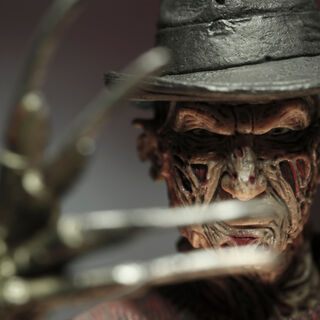Punishment
How Movie Villains Inform the Way We View Psychopaths
The 'monsters' of horror movies are often depicted as severely mentally ill.
Posted January 14, 2022 Reviewed by Tyler Woods
Key points
- In movies, the killers are often mechanical and inhuman.
- Audiences thrill at watching killers get torched, riddled with bullets, or thrown from great heights.
- Pop culture consistently tells us that there are some people who are not human. They are monsters worthy of physical annihilation.

American cinema features a long parade of celluloid killers carrying out creative, heinous murders. Though dating from the 1920s, the character of the “slasher” came into its own with the arrival of Michael Myers (Halloween), Jason Voorhees (Friday the 13th), and Freddy Kreuger (A Nightmare on Elm Street) in the final decades of the 20th century. The slasher's popularity boomed in the late 70's and 80's, when America experienced a full-blown panic over serial killers. This was the age of Ted Bundy, the Son of Sam, the Hillside Strangler, Jeffrey Dahmer, and Richard Ramirez. One notable thing about these serial killers was that while they looked like regular folks on the outside, inside is something foreign. Inside, they are 'monsters.'
Slasher movies help the audience identify the serial killer type with masked and burned faces. In movies, the killers are mechanical and inhuman, though some, like Freddy, seem to have a sense of humor. Regardless, we are visually cued to understand that these are not really human beings. They are unfeeling beasts.
The mental state of the cinema slasher is something oft-remarked upon in their films. Usually, some sort of expert, such as a psychiatrist or a police detective, breaks things down for us. In the Halloween movies, for instance, Dr. Loomis does the job. He has treated Michael Myers, and he often says something about his former patient being a “monster” or even “the boogeyman.” In the first movie, he explains that Myers must first be put on Thorazine prior to seeing a judge to discuss his release from a high-security mental hospital. He must be as incoherent as possible, so he can never leave custody. This is because Loomis knows Myers cannot be medically healed. Loomis demonstrates how to “fix” Myers in the first movie by shooting him repeatedly with a pistol.
That the movie slasher coincided with the real-life serial killer panic reinforced public perceptions. For example, Jeffrey Dahmer was constantly compared to Hannibal “the Cannibal” Lecter from Silence of the Lambs. Because the slasher is unhuman, and cannot be healed, he must be destroyed. Audiences thrill at watching killers get torched, riddled with bullets, or thrown from great heights. Sometimes the killer is first shown locked away in a mental hospital, but only as a means of setting up an escape scene. Movie mental hospitals are typically failures or haunted houses; they don’t work.
Slasher flicks are fantasy, of course. We all know that Jason and Michael Myers are not real people. But the idea that especially egregious acts of murder are carried out by “monsters” worthy of extreme punitive measures is real. This sentiment informs audience satisfaction in the destruction of the slasher, and it similarly powers public demands for capital punishment in some cases.
The death penalty is the ultimate punishment. It is final and controversial.
Wildly disproportionate to their share of the population, people suffering from severe mental illness have historically been put to death. According to the Washington, D.C.-based nonprofit Death Penalty Information Center, nearly two out of five people executed are diagnosed with severe mental illness, and one-third have suffered a traumatic brain injury or had an intellectual disability. Although the public generally agrees that severe mental illness should exempt a person from capital punishment, some of the highest-profile executions have been of perpetrators who clearly suffered from mental illnesses and are not of sound mind. For example, Lisa Montgomery, a federal prisoner executed in the final days of Trump’s presidency, suffered from a whole raft of serious mental illnesses.
This gets us back to the movies and popular culture. Criminal psychotics form a mainstay of the entertainment industry. Some of the most famous villains—such as Hannibal Lecter and the Joker—are portrayed in film as seriously mentally ill. Both of these bad guys have broken out of mental institutions. Their defeat always involves violence, not medicine.
Again, this is just fantasy, right? Clearly, we know the difference between Silence of the Lambs and the real-life person who kills and consumes a victim. The problem, as I see it, is that our main source for understanding violent psychosis is not the classroom, but the screen (cinema, TV, cellphone). Pop culture consistently tells us that there are some people who are not human. They are monsters worthy of physical annihilation. Dehumanization seems to be a crucial step in the creation of an enemy worthy of destruction. It is something worth thinking about when we ponder the death penalty.
References
"Mental Illness." Death Penalty Information Center. https://deathpenaltyinfo.org/policy-issues/mental-illness


